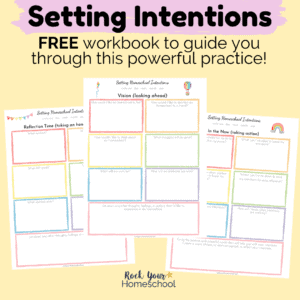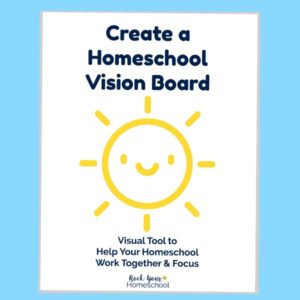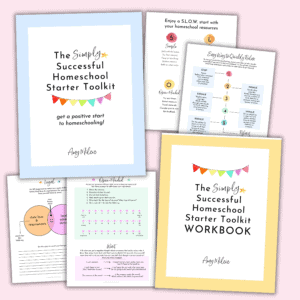Homeschool Basics: How to Get a Successful Start
This post may contain affiliate links. Please read my disclosure statement. Thanks for visiting!
These homeschool basics will show you what you REALLY need for a successful start (and continuation) to your learn-at-home adventures.
When you start homeschooling (or would like to boost it), it's important to keep it simple. I learned the hard way on my own homeschooling journey and wasted a lot of time, energy, and money. I'm sharing these practical tips and ideas so you can make the most of your start to homeschooling - and keep it going!
As you read through these suggestions, I encourage you to jot down any that you think could help your family. And please let me know if you have any questions!
Related: Want to know more about homeschool life? Get expert help from a veteran homeschool momon our Homeschooling 101 page!

Get Your Homeschool Started (or Back) on the Right Track
Are you on the fence about homeschooling? Wondering what homeschool basics you need to know to get started (or back on the track)?
Homeschooling feels intimidating for most parents. But, once you get your feet wet, you find out that it’s not as intimidating as you might imagine.
There are a few thing that you must do in order to get a solid start to homeschooling (like learning about the homeschool laws of your state).
And then there are a few things that you can do to make it easier and more successful for all (like finding a routine that works for your family).
Getting your homeschool started on the right foot can make a world of difference. It's not the end of the world if you didn't. You ALWAYS have time to try these tips and ideas if you feel like you haven't.
The big thing is that you want to be confident in your decision and you want your family to be excited for this journey you’re embarking on together.
Here are some of the homeschool basics that can help you build your confidence and success!
Related: Find out how to start homeschooling without going broke or losing your mind!
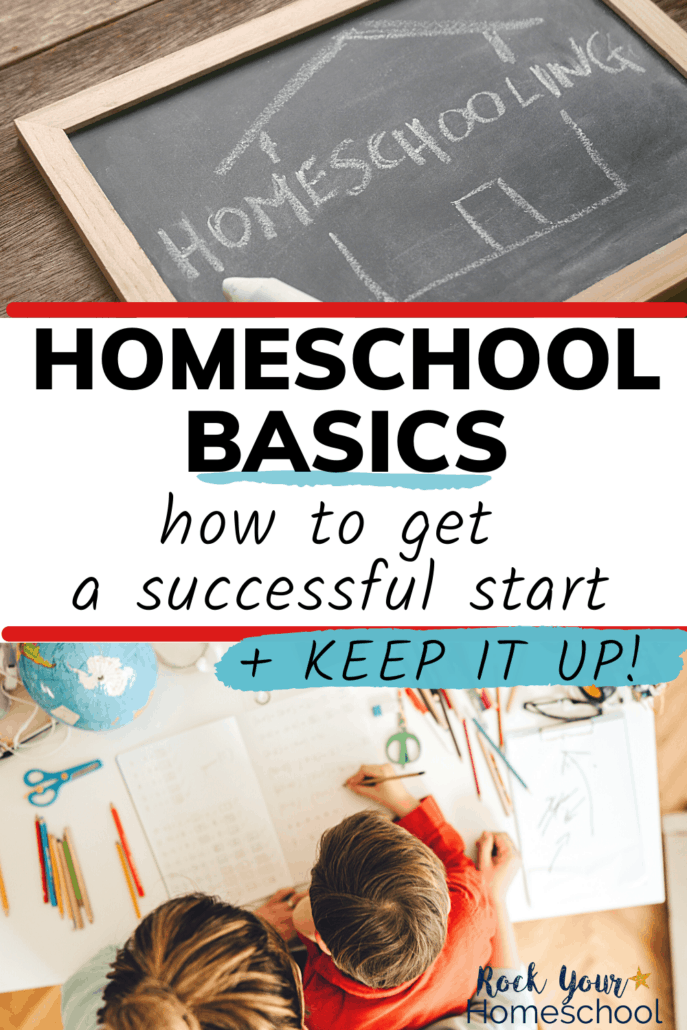
Homeschool Basics: Is It Right for Your Family?
The first step is decide whether or not homeschooling is right for your family.
This decision shouldn’t be made lightly. You have to think about all of the essential factors, such as:
- The time commitment it takes out of your family and you individually
- The pros and cons of homeschooling based on your family’s needs
- Your budget and how much money you have to spend on the essentials needed
Speak to your entire family about your opinions on home education. And talk to other homeschooling families and ask for their honest feedback.
Sometimes, the reality of homeschooling is different than what you might read on a blog post or see on Instagram. This first thing to do can make a big difference for new homeschoolers.
Consider these Homeschooling Pros and Cons
Here are some of the basic pros and cons of homeschooling:
| PROS | CONS |
| You can adapt the lessons to fit your child’s learning style. | Requires a time commitment for parents. |
| It’s flexible and works with any schedule. | Costs more money than public schooling. |
| You get to be there for all milestones. | You have to seek out socialization opportunities. |
| Your kids learn about what interests them. | It can be frustrating and challenging at times. |
| You can incorporate your beliefs easily. | It’s an adjustment for many families. |
| It’s cheaper than a private school. | It can feel like a lot of pressure. |
| Both parents can be involved. | You may worry about gaps or if your kids are missing out. |
| It gives more time for traveling and seeing the world. | Your kids may not be able to participate in specific activities only available at public school. |
| Families can find a schedule that works for all family members. | You might need to submit paperwork, if your state requires. |
Decide How to Work Homeschooling into Your Schedule
I see parents discussing often whether or not parents can work and homeschool at the same time. The answer is a resounding YES, but you have to figure out how to work it into your schedule.
I’ve always worked from home while homeschooling, usually working in the margins (blogging is flexible like that). Other families have both parents working outside the home and learn how to balance their schedules to make it work.
The great thing about homeschooling is that it’s individual. No one sets the times that you have to school your family. Some families don’t do any school work until the evening because they wait for a particular family member to get home for assistance.
I share tips and ideas for creating a daily homeschool schedule that can work for you. Also, consider a relaxed homeschool routine if you need flexibility!
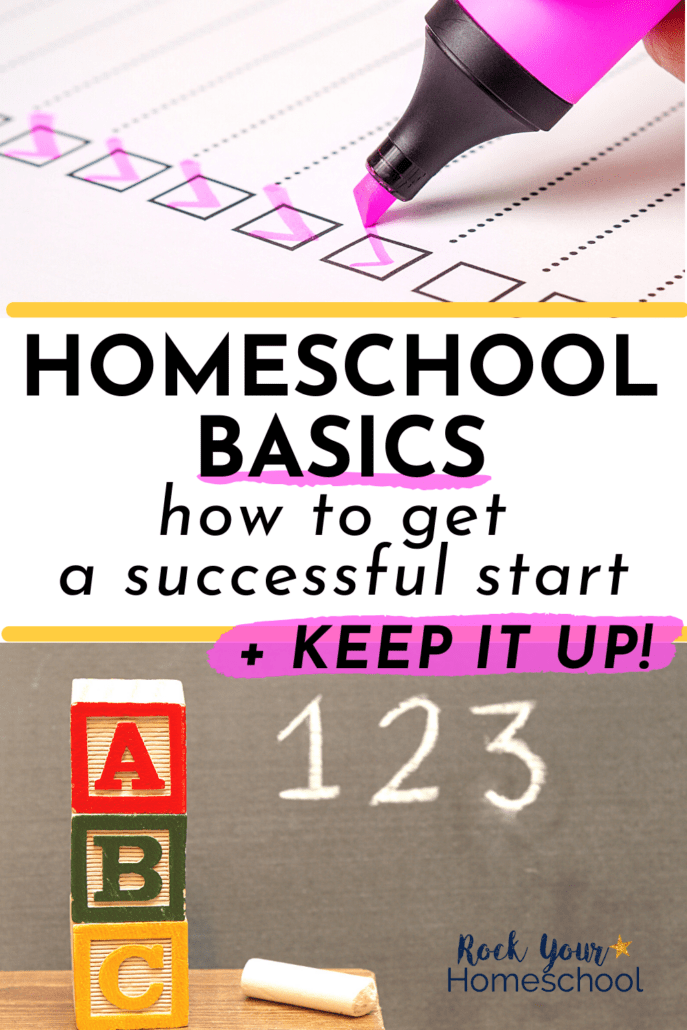
Homeschool Basics: Learn Your State Laws
Once you decide to give homeschooling a try, the most important thing is to learn the homeschool laws of your state. Each state has different requirements of your state, and while it’s legal in all 50 states, some states (like my state of Pennsylvania) have stronger regulations than others.
Some state's homeschool regulations require that you send a notification of intent to homeschool, such as Ohio. Other states have no requirements for notifications that parents need to send the school district.
You might also need to create a homeschool portfolio, submit a notarized affidavit (sounds a lot scarier than it actually is!), or have your child take state testing.
Parents are responsible for understanding what is required to withdraw their child from public school and the requirements to start homeschooling.
If your child isn’t yet of age to go to school (or within your state's compulsory age), know the age by which you have to let the state you’re homeschooling your child.
Send in a Notice to Your Local School District (If Required)
Once you learn the homeschool laws, if your state requires a notice of intent to homeschool, you need to find out when you need to send the notice. Every state has a different requirement.
Some states say that you can send it whenever you want, but it’s typically advised to send it two weeks before the start of the school year for the district in which you live.
Make sure you get this part right by asking local homeschooling families and checking out HSLDA (Home School Legal Defense Association). This site has more helpful resources that you can use as you develop your home educational program.
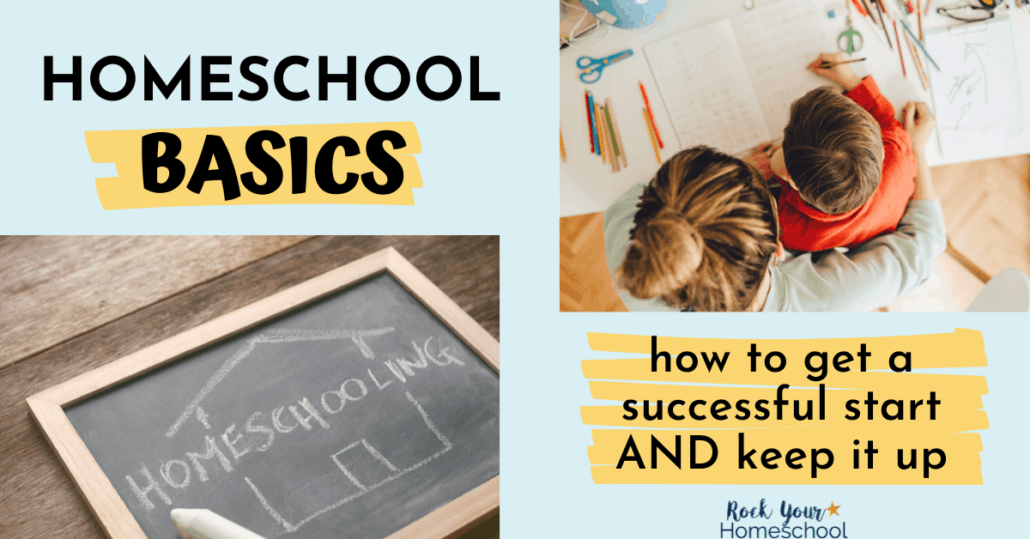
Decide What Curriculum You Want to Use
One of the best (and hardest) homeschool basics is selecting curriculum. Finding the best homeschool curriculum for your family can be a challenge but you can do it!
Years ago, this basic for your homeschool program was easier because you only had a few options. Nowadays, there are dozens of options with a wide range of cost. Some curricula have a minimal cost, while some might cost over $1,000 per child. There is no average cost because it varies so widely.
I spent weeks searching online when I first started homeschooling. I read every single homeschool curriculum website that I could find. I overspent, buying things that didn’t work for our family, and I felt like we needed to try it all.
Some parents love curriculum searching, but if possible, it’s nice to find something that you really initially enjoy so that you can get the hang of teaching your kids.
Here are some suggestions when it comes to deciding what curriculum you want to use:
1. Think about Your Lifestyle
Does your family enjoy spending time at home? Or do you like to be on-the-go as much as possible?
Do you want to include religion or not (secular)?
Do you feel like your schedule is busy or have multiple kids to teach so you need something open and go?
These are a few considerations you need to think about when you pick a curriculum. If your homeschooling family is busy and often on the go, you might want something that requires less hands-on activities and more pre-planned lessons with scripts for parents.
2. How Do Your Kids Learn
All kids learn differently. Actually, all humans learn differently 😉
It’s valuable to understand your child’s learning style. Some people are visual learners who need to see it to learn it. Others are auditory learners who learn best by hearing the information. Then, you have kinesthetic learners who learn best by doing; this tends to be the hardest one for schools to accommodate.
One of my kids learns best by seeing and reading it. If he reads it, he remembers it, so it’s easy to pick a curriculum that leans heavily on reading.
Another of my boys is an auditory learner, so he needs to be read to and explained what he is being taught. Audiobooks are also amazing for him!
Consider how your kids learn the best and find a curriculum that provides ample opportunities. This step will help your encourage a love of learning throughout your years of homeschooling.
3. What Do You Envision for Your Homeschool
When you think about homeschooling, what pops into your mind?
Do you think about doing endless projects with your kids or going on weekly field trips? Do you envision everyone sitting around a table reading books together and learning as a family? Perhaps, you imagine your kids each working independently on what works the best for them with you as the monitor?
Your vision for your homeschool is unique to your family, but it matters.
Not all homeschool programs are the same. Some are meant for families to work together, while others are individual and work best when your child studies at their own pace.
Setting homeschool intentions can be a powerful practice when it comes to determining and achieving your vision. Grab this free printable pack to get started!
Oh, and you can use this free homeschool vision board pack to create an awesome visual tool for all ages to work towards your vision.
4. Be Okay with Switching & Trying Something New
It can help to know that what you start with might not work - and that’s okay.
Most homeschooling families switch curriculum materials a few times until they find what works the best for their kids. Be OK with switching - it’s the reality for most families.
Oh, and it's okay to piece together curriculum, too! Our homeschool approach is eclectic. I select curriculum for each subject for each boy based on what works best for them (and our budget).
I highly recommend that you frequent your local library where you can find wonderful homeschooling resources to use for required subjects and enrichment.
Look for a Support Group (or Two)
Meeting with other homeschoolers in your area can be super helpful, but it can be tricky. You may live in an area (like we do) that doesn't have many homeschoolers. Or it can be difficult to make schedules work.
A great place to find local homeschoolers is Facebook. You can also find some amazing homeschool groups to get your questions answers about curriculum and more. I invite you to join my Facebook group, Rock Your Homeschool!, where we have a lot of fun chatting about our homeschooling years.
Support groups for homeschoolers encourage you when you need it. And trust me - you’ll need to be encouraged because homeschooling is rough sometimes.
The group members can help you pick the right curriculum for your family, help you find field trips, and inspire you with fun homeschool ideas.
Find a Routine or Schedule That You Like
Once you have your curriculum picked out, it’s time to develop a routine or schedule that works for you.
Our family prefers a routine over a schedule (with specific times). You can learn more about our relaxed homeschool routine (and get a free printable pack to establish your own) HERE.
A schedule or routine will probably be unique to your family. No state has requirements for when a family has to start their school day.
You might school your kids during the morning or afternoon. That's one of the really cool benefits of homeschooling - you can do what works best for your family.
Figure Out a Planning Style That Works for You
Some homeschoolers plan out their entire year at once. That approach works for some families but it can be difficult if you want your year to be flexible, adapting to field trips and park time with friends. Other families (like ours) find it better to plan week by week.
Some families don’t have a plan or schedule at all. These homeschools flourish by going with the flow.
Also, I recommend that you look at how you currently plan your family life. Do you use paper or online planners? Go with what works for you!
Map Out Your Year
Even if you don’t plan, I suggest that you map out the year. This step might simply be to finish the curriculum that you bought by the end of the school year.
Or you might have more in-depth plans for your school year that include which books to read and when, science experiments, and more.
Having a map of your upcoming year serves as a guide for what you want to accomplish for the year. You can use this to determine how to break down your year into what would be good to get done each month and then week.
You also want to make sure you have goals for the year. These goals should be what you would like for your children to accomplish by the end of the year. For example, if you have a preschooler, a goal might be that they learn the entire alphabet and counting to 20. If you have an older child, a goal might be to know all U.S. states and capitals.
And you can also have goals for your homeschool as a whole (like wrapping up work for the day by 3pm or enjoying a cooking project once a week).
Start Record Keeping as Part of Your Homeschool Basics
Record keeping can be done in a variety of ways. You may want to choose based on your storage space, number of kids you're homeschooling, or style preference.
Some states have no requirement for record keeping. Make sure you take a look at what your state requires first before deciding how you want to keep a record of what your children complete.
If you need (or opt) to use a homeschool portfolio for your kids, you will want a folder or box to store the items you wish for the portfolio.
A homeschool portfolio needs to show your child’s progress throughout the school year through examples of work and photos from experiences your family enjoyed.
Assessing your students' progress can go with record keeping. Try these creative assessment ideas if you'd rather not use more traditional approaches (like standardized tests).
Understanding the Homeschool Basics so You Can Thrive
Figuring out the homeschool basics may take a bit of time. You have a lot to sort through and try to figure out what works best for your family.
My tips for the best way to begin: Take it slow, ask questions, and know that it doesn't have to be perfect.
Yes, it's a big responsibility to homeschool your kids. But, you're taking steps to make sure that you're doing everything you can to get a successful start.
Keep it simple and focus on WHY you've started this amazing homeschool journey of learning adventures at home! You're already on your way to rockin' your homeschool ⭐️
If you could use additional help or guidance with these homeschool basics, make sure to check out The Simply Successful Homeschool Starter Toolkit (+ Workbook)! It's a fantastic resource that lays out all of these ideas, tips, and more.



